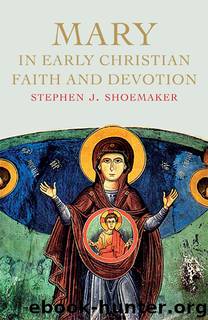Mary in Early Christian Faith and Devotion by Stephen J. Shoemaker

Author:Stephen J. Shoemaker
Language: eng
Format: epub
ISBN: 9780300217216
Publisher: Yale University Press
Conclusions
Along with the Book of Mary’s Repose, which we considered in the previous chapter, the Six Books Dormition Apocryphon shows sig-nificant evidence of the growth of Marian piety during the “tunnel period” between the second-century Protevangelium and the Nestorian controversy of the early fifth century. The Book of Mary’s Repose, as we noted, is especially significant for its remarkable portrayal of Mary as one learned in the cosmic mysteries and for its early witness to the practice of Marian intercession. Nevertheless, the Marian veneration of this earliest Dormition narrative is rather basic, as perhaps one might expect from such an early text: one finds only scattered references to the efficacy of Mary’s intercessions with her son, which are framed within a setting that also includes intercessory prayers from the apostles and angels. The Six Books Apocryphon, however, shows that a much more developed cult of the Virgin had come into existence already by the middle of the fourth century, in which the focus on Mary’s intercessions has intensified considerably and has been joined to belief in Mary’s power to work wonders and her apparitions. In addition, the Six Books narrative affords what is most likely the earliest witness to liturgical commemorations of the Virgin, in the form of three annual liturgical feasts celebrated in her honor with bread offerings on her behalf.
Perhaps Epiphanius stumbled across these traditions while searching for knowledge about the end of Mary’s life. Clearly, however, he did not care very much either for the Dormition traditions themselves or for the Christians who followed them, inasmuch as he published two separate invectives against both. Although in one instance he feigns ignorance of any Dormition traditions in rather dramatic fashion, undoubtedly he had in fact encountered the traditions of Six Books. Accordingly, his insistence that he could not find any traditions at all about the end of Mary’s life should be taken with a grain of salt: it would appear that he had found some traditions but just none that he could approve of. Moreover, the explicit connection between the ritual practices of the Kollyridians and belief in Mary’s Assumption in Joseph’s Bible Notes affirms that these two traditions almost certainly were already linked when Epiphanius encountered them, leading us straight to the Six Books Apocryphon.
It is also worth noting that in this instance, once again, early veneration of the Virgin is associated with heterodox Christianity, at least as judged by Epiphanius. In actual fact, there is nothing at all in the Six Books or even in Epiphanius’s account of his opponents’ reverence for Mary that would suggest even the slightest hint of heterodoxy. Epiphanius objects to the fact that these Christians are offering veneration to Mary in the context of a broader argument that reveals his opposition to the veneration of any figure other than God. Such ritual actions, whether directed to Mary, Thecla, Elijah, or John, are tantamount to idolatry and must be condemned as such. Yet in this respect Epiphanius seems to have actually been
Download
This site does not store any files on its server. We only index and link to content provided by other sites. Please contact the content providers to delete copyright contents if any and email us, we'll remove relevant links or contents immediately.
Resisting Happiness by Matthew Kelly(3326)
The Social Psychology of Inequality by Unknown(2990)
Day by Elie Wiesel(2753)
Designing Your Life by Bill Burnett(2704)
The Giving Tree by Shel Silverstein(2313)
Human Design by Chetan Parkyn(2050)
Angels of God: The Bible, the Church and the Heavenly Hosts by Mike Aquilina(1944)
The Supreme Gift by Paulo Coelho(1938)
Jesus of Nazareth by Joseph Ratzinger(1786)
Hostage to the Devil by Malachi Martin(1784)
Augustine: Conversions to Confessions by Robin Lane Fox(1754)
7 Secrets of Divine Mercy by Vinny Flynn(1714)
Dark Mysteries of the Vatican by H. Paul Jeffers(1694)
The Vatican Pimpernel by Brian Fleming(1685)
St. Thomas Aquinas by G. K. Chesterton(1620)
Saints & Angels by Doreen Virtue(1594)
The Ratline by Philippe Sands(1544)
My Daily Catholic Bible, NABRE by Thigpen Edited by Dr. Paul(1476)
Called to Life by Jacques Philippe(1466)
